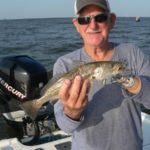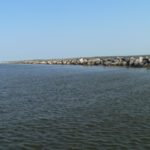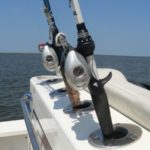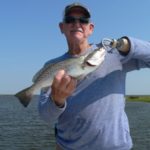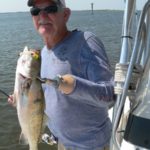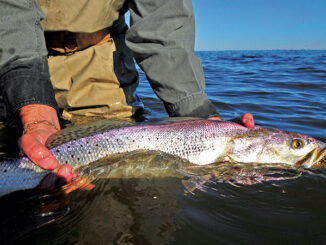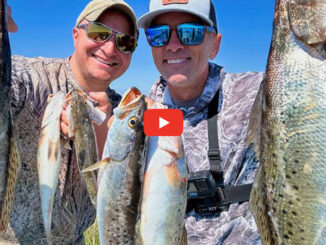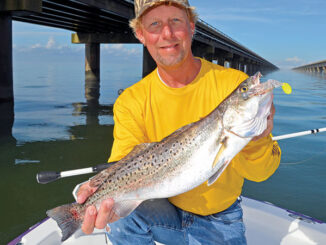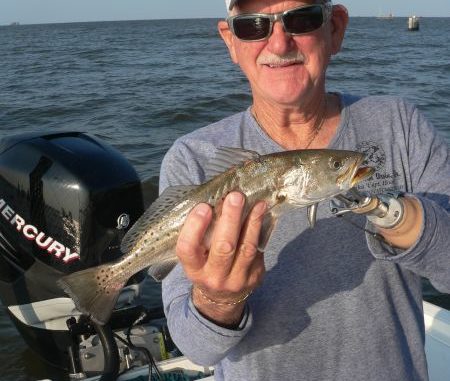
Shell Beach and Hopedale offer sensational fall speck action, and this old salt knows exactly how and where to catch them.
I think the first time I fished with Capt. Tim “Hook” Ursin Jr. was back in the early to mid-1990s. At the time he was running his charter service out of the End of the World Marina on Delacroix Island — and we were both a lot younger then.
But I remember that first trip. We ran all the way to Breton Island and limited out on speckled trout.
We’ve fished many times since, and each trip has been memorable in its own right. To quote one old salt, “Every fishing trip I take is the best one I ever took, until the next one.”
I called Ursin, the owner of Escape Fishing Charter, recently to see if he was up for yet another excursion, saying I wanted to go see if we could fling some trout over the gunnel.
Fortunately, he was willing to use his day off to take me fishing, so we met at his home port in Shell Beach at daybreak.
We left Campo’s Marina with a baitwell loaded with live shrimp and pointed the bow southeast toward the bigger water of the fringe bays.
I volunteered my 24-foot Triton as our steed for the day, and my Verado provided the push.
But as soon as we hit the Ship Channel we were met by some pretty stiff winds, as a forecasted cold front arrived a bit ahead of schedule to make our day more challenging.
Our plan was simple enough: Hook said the trout were migrating back into the marshes from the outside waters where they spent the summer.
But he said the big bays were still holding a lot of nice-sized stragglers.
“I’ll still fish the Bay Eloi rigs and structures this month, and even out farther into the sound,” Ursin said. “Five Wells, the Dope Boat, the Rocks, Little Central — all that holds fish in October.
“The action does get more hit-and-miss, and even when you find them you might not catch a ton of them at any one spot. But the ones you catch will be nice-sized, and you’re almost guaranteed to pick up some big redfish out there, also.”
I knew we were in for a long ride because Ursin likes to hit the fringe bays on the far side of Neverland.
“Whenever possible this month, I’ll make the run over to fish the upper east side of the Biloxi Marsh, in the big fringe bays where the white shrimp are flowing along in the current in all the main migration routes,” he said. “The trout and redfish instinctively know their primary food source is going to be in abundant supply in those areas, and they show up in big numbers to devour them.”
And the fish are hungry.
“The trout will be putting on as much weight as possible right now before the winter months arrive, so they’re in a flat-out feeding frenzy,” Ursin explained. “That means areas like Blind Bay, Three Mile Bay, Nine Mile Bay, False Mouth Bay, Bay Boudreaux, Bob’s Lakes, Lawson Bay, Christmas Camp Lake, Lake Eugene, Fishing Smack Bay and even out to Drum Bay are all on my favorite-spots list — not just for this month but in November, as well.
“It just makes for a long ride from the old home port.”
But the ride gave us time to catch up. Ursin is now 72 years old, making him the official “old salt” of the area charter guides.
And he’s been guiding since the 1980’s, so he’s spent many, many days on the water chasing both speckled trout and redfish. That means he knows what to look for and where and when.
For those who don’t know it, he’s known as Capt. Hook because his left arm was shot off in 1973 by a crazed gunman who went on a murderous rampage against police and firefighters from New Orleans’ downtown Howard Johnson Hotel.
Ursin was a young lieutenant in the fire department back then, and on that fateful day in January ’73, his unit was called to fight a fire set by that gunman (whose name is so vile I refuse to mention it) in the Howard Johnson.
They didn’t know it was an ambush.
Tim was eight stories high, hanging on the ladder of the ladder truck with a fire hose curled around his neck and shoulder when the gunman appeared from an upper balcony and shot him with a .44 magnum.
The impact virtually severed his arm and would certainly have severed his head if the heavy bronze fitting of the fire hose wrapped around his neck hadn’t stopped it.
It was nothing short of a miracle that Tim didn’t die from that gunshot wound or that he didn’t fall off the ladder to his death in the street far below.
True, he lost his lower left arm. But nine people died in that bloody rampage, including five policemen. Thirteen others were wounded before the shooter was killed.
So, that’s how he came to wear a hook, and would eventually become known as Capt. Hook.
He tried being a salesman for awhile after the incident, but being inside all day didn’t suit him. He loved to fish and was good at it, so he decided he’d try to make a living doing something he was passionate about.
He became a charter guide in the early 1980s, and he’s been at it ever since.
Like I said, I’ve fished with him for decades now, and in all those years and on all those trips I never once thought of him as being handicapped. He does everything you and I do (probably better than we do it), from tying knots to casting and retrieving with strength and skill.
It’s a tribute to his tenacity, and I take my hat off to him.
The cool morning air and the lack of humidity on our latest trip made for a pleasant boat ride, and the fact that you don’t have to leave the dock at dark-30 made it all the more enjoyable. It’s the reason so many anglers consider October and November absolutely their favorite time of the year to fish.
The Hookmeister said speckled trout will filter into the Biloxi Marsh from the outer bays, and they’ll do it through the aforementioned waters.
“We know they don’t come in through Halfmoon Lake and Long Lagoon, because we don’t catch any trout in there,” Ursin said. “But we do catch trout in Christmas Camp Lake, Lawson Bay, Fishing Smack and Lake Eugene, and from there they’ll move deeper into the marsh as the weather and water temperatures cool down.
“Naturally, you’ll want to fish a moving tide, and I like to look for current lines around prominent points, where the trout and reds will wait to ambush the bait flowing along with the current.”
I admit I’m a bit of a fishing gear junkie, so I like to see what others are using. Ursin came aboard with a smallish tackle box packed full to overflowing, and three rod and reel setups, all baitcasters.
“What? No spinning reels?” I asked.
“No. I rarely ever use them,” Ursin said. “I always use baitcasters, even on windy days — and, yes, I even use them to fish under a cork.”
I also prefer fishing with a baitcasting reel, but I gave up trying to use them with a cork. I always wind up with a bird’s nest bigger than Dolly Parton’s hair, so all my cork fishing is with spinning reels.
And I have about half of my reels spooled with braid, the other half with 12-pound mono, preferably Trilene XL.
I prefer mono when cork fishing because I avoid the two aggravations that I haven’t figured out how to escape with braid: tip wraps and wind knots.
I hate it when the wet, limp braid wraps around the tip of my rod when I pop the cork. You can’t unwrap it with a simple jiggle of the rod like you can with mono.
Ursin, too, gets irritated by the same things, and said he fishes exclusively with mono throughout spring, summer and fall.
Only in winter does he switch to braid because of the added sensitivity when bottom fishing, he explained.
The reels he brought aboard were all Pflueger low-profile baitcasters. Ursin said they cost about $90 each and cast as far or farther and hold up as well as any $200 baitcaster he’s ever used.
For bait, Ursin is definitely convinced that live shrimp on a treble hook will give you the best chance for success.
“I started using treble hooks again, and I do believe I miss fewer fish,” he said. “But they can be harder to deal with: They snag everything, including the landing net.
“And I make it a point to bring live bait if it’s available, even when I know the trout are hitting plastics — even if I bring it just for insurance, because there are those days when the fish are finicky and they won’t hit plastic.”
But he said in the fall the trout usually will bite soft plastics.
“I get them started on live shrimp; then, once you catch some fish, you can switch to plastic,” Ursin explained. “I’ve been using the Vudu shrimp very successfully, either under a cork, or tight-lining them double rigged.
“The trout have been tearing up these Vudu double rigs.”
But on this cool, windy morning, the fish wouldn’t touch his plastics or mine. We tried them tight-lined and under a cork, tandem and single rigged, and caught nary a trout.
We did, however, catch an assortment of junk fish that thoroughly enjoyed the live fare to which we had switched.
Ursin’s treble hook pulled up several small croakers, catfish, needlefish and a few undersized specks, while my larger kahle hook came up bare.
“You know there’s no big fish down there when you keep catching all these little dink fish, or the big fish would be eating them,” Ursin said. “We have to move on.”
We had already given up on a couple other spots that should have produced but didn’t. We tried to anchor in open water at a structure that produced some specks the previous week, but the anchor didn’t want to stick in the bouncing seas.
We tried the rocks along the MRGO and picked up a couple of bites before that action died.
Next stop was to park off a marsh island that had a nice shell bank visible above the surface. But we were anchored too far from the shell bank to reach it, even with a long cast.
“The fish aren’t on the bank,” Ursin said. “They’re 20 to 30 yards out in front of it, around some bottom structure.”
He made a cast to indicate where I should toss my live shrimp, so I plunked it down close to his cork.
The bite was slow getting started, but with a live shrimp dangling under a cork and a little patience, we started putting some trout in the boat.
Within a few minutes, both of us were reeling in a nice-sized specks. The action wasn’t fast and furious, but it was steady enough to keep us there, especially with the way the wind was whipping up the water all around us.
“I’d be tempted to move under different circumstances,” Ursin said. “The usual tactic is to follow the 10-minute rule: Give an area 10 minutes or so to produce and, if it doesn’t, move elsewhere.
“You always look for decent water, nervous water, like at points where there is a good current line. You also want a moving tide and to look for bait activity in the water. To know if the water is clear enough to fish, drop your trolling motor over and if you can see the foot of it, that water is plenty clean enough to fish.”
But on this particular day, Ursin was violating his own 10-minute rule.
“There are exceptions for every rule, and the exception is when you fish this kind of day,” he said. “Very windy, finicky fish — that’s why we’re staying put unless the action all vanishes.
“On days like this I don’t like to leave fish to go look for fish.”
Ursin said another option open to anglers this month is to cross Lake Borgne from Shell Beach and fish the mouths of the various bayous, especially on a falling tide.
Bayou Grande, Lakeshore Bayou, Bayou Biloxi, Bayou Magill, False Mouth Bayou, Cop Cop Bayou, Bayou Sue and St. Malo are all worth trying.
You can also usually find both reds and specks working along the shoreline of Lake Borgne, fishing at the various points, coves and drains from the marsh.
Soft plastics under a cork or tight-lined, gold spoons, beetle-spins or live shrimp under a cork will get the bite.
Ursin said you can troll and cast toward the shore with spoons and spinners for reds, and cast out to open water with live shrimp or soft plastics under a popping cork for specks.
Once you find some action, stick the Power-Pole down and see if the action will continue for awhile. When it stops, resume trolling until you bump into fish again.
Ursin said he had hardly seen any birds diving over bait so far this season.
“Usually we see flocks diving all over this time of year,” he said. “Now, this could change at any moment, but we just haven’t seen them — even in late summer.
“But if you do find a flock of diving seagulls, I’d stop and fish them because the trout under them in the fall are bigger than what you usually find in the spring. We put a lot of keeper-size trout in the box from under the birds in the fall.”
The morning wore on and our box of fish was plenty full enough to call it a day. The mild temperature and low humidity made for a very pleasant trip and an enjoyable ride back to the dock.
It was the best fishing trip I ever had.
Until the next one.
Editor’s note: Capt. Tim “Hook” Ursin Jr. can be reached at 504-512-2602.
